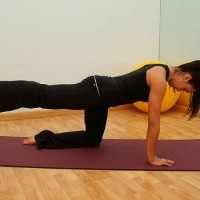Written by Lauren Rae, CPT and Wellness Coach for TRYM Fitness
Let’s be honest, Pilates has gotten a bad rap in the past as a “fake” sort of workout where you lie down the whole time. Especially with the new “push harder,” “go faster” mentality among fitness fanatics. I took Pilates my first semester at college, thinking I could easily use this morning class to fill physical fitness requirements and more so as a quaint nap time. I was greatly mistaken and wildly impressed at the level of difficulty in using your own body weight for an inner muscular workout.
Boutique gyms are popping up everywhere and people are flocking to new types of training methods to get active. As this new wave of fitness craze grows, techniques that were once designed to heal, mend, and strengthen have turned into the hot new boot camp style workout. As a result, Pilates has left the majority of the ballerinas and gone viral to the general public that seek body transformation.
Pilates was designed by Joseph Pilates while he was in Germany volunteering during WWI. Working with bedridden patients, he began rigging springs to hospital beds to allow these patients to exercise in bed with the assistance and work of resistance. This innovation eventually led to the design of the Pilates Reformer. A surprising fact on the Balanced Body website mentions that while many patients were dying of disease and decay during WWI, none of Joseph Pilates’ patients died. It is suggested that it was his use of resistance training that helped them beat death.
What is the Purpose of Pilates?
Body Awareness & Balance
Body awareness is simply the understanding of where our bodies are in space and how we move in space. It involves all of our sensory abilities and allows for the learning of balance and stability. Think of a baby learning to walk. It takes trial and error, but eventually the child is able to achieve the muscle memory to hold itself upright and move in different planes of motion. The same idea is present in learning body awareness through Pilates. The movements are designed to strengthen and challenge your mind and muscles and create a connection that serves functional movement.
 Overall Muscle Tone & Core Strength
Overall Muscle Tone & Core Strength
To build muscle and core strength it is important to work with resistance. This type of training is simply any exercise that causes the muscles to contract against the chosen weight. In Pilates, working with the resistance of reformer cables and springs as well as your own body weight increases the overall muscle mass of your body. This type of resistance encourages muscle tone as the amount of time spent under resistance is great while the weight load is light, therefore the work can remain in the muscle longer to create lean muscle mass rather than bulky muscle mass.
As the general public searches for health and body perfection, I often hear of people getting hurt in some of the newer Pilates class style. Some studios are taking this very particular muscle training style and turning it into a money making boot camp bank. Too much downward pressure on the knee, tightness in the low back, sharp shoulder pain—some of the same ailments you hear about from high intensity training styles. That being said, responsibility lies in the hands of the studio owners and teachers as to how to educate clients. And the benefits of learning and utilizing Pilates to further advance your health and wellness journey far outweigh the negative stigma of the mat and reformer workouts.






